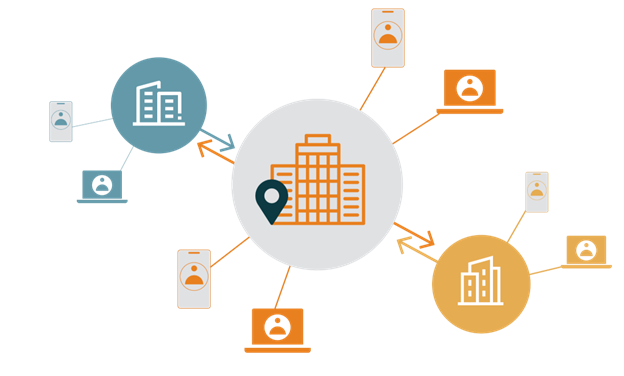By Katie Penland, TechChange Manager, Hybrid Events
The best part about planning a hybrid event is that there’s no limit to how creative you can be. One of my favorite ways to combine the benefits of virtual technology with the organic energy of in-person gatherings is what we at TechChange call “Hub and Spoke.” Let’s go over the basics of this model and I’ll share my top suggestions based on my experiences managing large-scale implementations of it such as the Global Digital Health Forum and the Global Digital Development Forum.
The Hub and Spoke Model, Defined
In a classic hybrid event, content is generated only in the central venue and shared virtually with online participants. So, for example, your organization rents out a conference hall in Washington D.C. and livestreams the sessions out to people online–who may be located anywhere. This is a great start for inclusivity, but it means that content only goes one direction…so there’s no way for the on-site participants to connect with the virtual attendees, resulting in an unfortunate loss of networking potential and expertise.
Now the Hub and Spoke model of a hybrid event combines the main in-person event with auxiliary, secondary sites such as “watch parties” or happy hours. Content is generated in both the main site and the auxiliary sites, and shared virtually with everyone. People can join the central event, the auxiliary sites, or log in independently. This flexibility allows an incredibly wide range of experiences and modes of participation.
Tie Both Aspects Together to Cultivate Community Across Locations
As inclusive event managers, we want to connect people across that range of experiences and locations. Hosting “watch parties,” such as the events we held for GDHF in Indonesia, Tanzania, Kenya, Nigeria, St. Lucia and Chile, is a great way to enmesh virtual and in-person participants and ensure that your event isn’t just a one-way stream. Other approaches include happy hours, site visits, and learning luncheons that pair broadcast of conference content with facilitated dialogues on-site in satellite locations. I love helping our partners to cultivate community by thoughtfully designing connections and learning opportunities for all participants.
More suggestions for building community across locations:
- Designate a person at the in-person sessions to read out questions on behalf of virtual participants, noting their name and location.
- Offer 2-way hybrid production, ensuring quality inputs from your auxiliary locations. You don’t want people tuning out because they can’t hear or see the speakers who aren’t directly in front of them.
- Run a “pop up studio” or other on-the-ground live feed so online participants get the feel of the in-person experience at the “hub.” At TechChange events, we broadcast interviews with high-level speakers and conference attendees through our Learning Platform between sessions to keep things fun and interesting.
Empower Local Voices by Bringing Them to the Forefront
Some of the most knowledgeable experts on international development issues are in Low-to-moderate income countries, and they might not have the ability to travel to participate in the in-person elements of your hybrid event. More than a seat at the table, we work to ensure local experts have an opportunity to share their insights. At the GDHF 2023, we broadcasted ten hybrid sessions from the watch party sites, so that virtual and in-person participants could benefit from local expertise on everything from the future of Digital Investment Coordination (Nigeria) to Community Health Systems (via a two-way plenary between DC and Nairobi).
Consider the following ideas to center local voices in your event design:
- Elevate an “ambassador” to do introductory remarks at the auxiliary sites, and have them do social media posts summarizing their local events. For our GDHF watch parties, we reached out to local leaders and tech entrepreneurs to play this role. And since their time is valuable, we always offer a small stipend to support their efforts.
- Broadcast content from auxiliary sites to the main event over meal times or coffee breaks, and in designated watch room areas for virtual participation. Have signage and speakers remind on-site participants of virtual sessions and watch party connections.
- Include frontline experts in your plenary sessions. For example, one of our most popular GDHF sessions was a plenary that featured a Kenyan community health worker alongside international experts and funders.
People love to feel like they’re a part of something truly global. At the end of the day, a dynamic mix of sessions, topics, and modalities for learning and engagement will make your event one that people talk about– and return to year after year, whether in-person, at an auxiliary location, or online.
For more inspiration on hybrid event models, check out our Hybrid Events Playbook, or connect with our events team today.




